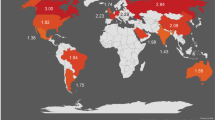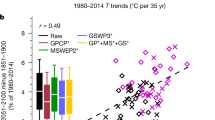Abstract
Human influence on climate has been detected in surface air temperature1,2,3,4,5, sea level pressure6, free atmospheric temperature7, tropopause height8 and ocean heat content9. Human-induced changes have not, however, previously been detected in precipitation at the global scale10,11,12, partly because changes in precipitation in different regions cancel each other out and thereby reduce the strength of the global average signal13,14,15,16,17,18,19. Models suggest that anthropogenic forcing should have caused a small increase in global mean precipitation and a latitudinal redistribution of precipitation, increasing precipitation at high latitudes, decreasing precipitation at sub-tropical latitudes15,18,19, and possibly changing the distribution of precipitation within the tropics by shifting the position of the Intertropical Convergence Zone20. Here we compare observed changes in land precipitation during the twentieth century averaged over latitudinal bands with changes simulated by fourteen climate models. We show that anthropogenic forcing has had a detectable influence on observed changes in average precipitation within latitudinal bands, and that these changes cannot be explained by internal climate variability or natural forcing. We estimate that anthropogenic forcing contributed significantly to observed increases in precipitation in the Northern Hemisphere mid-latitudes, drying in the Northern Hemisphere subtropics and tropics, and moistening in the Southern Hemisphere subtropics and deep tropics. The observed changes, which are larger than estimated from model simulations, may have already had significant effects on ecosystems, agriculture and human health in regions that are sensitive to changes in precipitation, such as the Sahel.
This is a preview of subscription content, access via your institution
Access options
Subscribe to this journal
Receive 51 print issues and online access
$199.00 per year
only $3.90 per issue
Buy this article
- Purchase on Springer Link
- Instant access to full article PDF
Prices may be subject to local taxes which are calculated during checkout



Similar content being viewed by others
References
IDAG (International ad hoc Detection and Attribution Group). Detecting and attributing external influences on the climate system: A review of recent advances. J. Clim. 18, 1291–1314 (2005)
Hegerl, G. C. et al. Multi-fingerprint detection and attribution of greenhouse-gas and aerosol-forced climate change. Clim. Dyn. 13, 613–634 (1997)
Tett, S. F. B., Stott, P. A., Allen, M. R., Ingram, W. & Mitchell, J. Causes of twentieth-century temperature change near the Earth’s surface. Nature 339, 569–572 (1999)
Zhang, X., Zwiers, F. W. & Stott, P. A. Multi-model multi-signal climate change detection at regional scale. J. Clim. 19, 4294–4307 (2006)
Stott, P. A. Attribution of regional-scale temperature changes to anthropogenic and natural causes. Geophys. Res. Lett. 30 1724 doi: 10.1029/2003GL017324 (2003)
Gillett, N. P., Zwiers, F. W., Weaver, A. J. & Stott, P. A. Detection of human influence on sea level pressure. Nature 422, 292–294 (2003)
Jones, G. S., Tett, S. F. B. & Stott, P. A. Causes of atmospheric temperature change 1960–2000: A combined attribution analysis. Geophys. Res. Lett. 30 1228 doi: 10.1029/2002GL016377 (2003)
Santer, B. D. et al. Contributions of anthropogenic and natural forcing to recent tropopause height changes. Science 301, 479–483 (2003)
Barnett, T. P. & Pierce, D. AchutaRao, K. Santer, B. & Gleicker, P. Penetration of human-induced warming into the world’s oceans. Science 309, 284–287 (2005)
Gillett, N. P., Weaver, A. J., Zwiers, F. W. & Wehner, M. F. Detection of volcanic influence on global precipitation. Geophys. Res. Lett. 31 L12217 doi: 10.1029/2004GL020044 (2004)
Lambert, F. H., Stott, P. A., Allen, M. R. & Palmer, M. A. Detection and attribution of changes in 20th century land precipitation. Geophys. Res. Lett. 31 L10203 doi: 10.1029/2004GL019545 (2004)
Lambert, F. H., Gillett, N. P., Stone, D. A. & Huntingford, C. Attribution studies of observed land precipitation changes with nine coupled models. Geophys. Res. Lett. 32 L18704 doi: 10.1029/2005GL023654 (2005)
Hulme, M., Osborne, T. J. & Johns, T. C. Precipitation sensitivity to global warming: comparison of observations with HadCM2 simulations. Geophys. Res. Lett. 25, 3379–3382 (1998)
Dai, A., Fung, I. Y. & Del Genio, A. D. Surface observed global land precipitation variation during 1900–88. J. Clim. 10, 2943–2962 (1997)
Held, I. M. & Soden, B. J. Robust responses of the hydrological cycle to global warming. J. Clim. 19, 5686–5699 (2006)
Hegerl, G. C., Zwiers, F. W., Kharin, V. V. & Stott, P. A. Detectability of anthropogenic changes in temperature and precipitation extremes. J. Clim. 17, 3683–3700 (2004)
Allen, M. R. & Ingram, W. J. Constraints on future changes in climate and the hydrologic cycle. Nature 429, 224–232 (2002)
Cubasch, U. et al. in Climate Change 2001: The Scientific Basis (ed. Houghton, J. T. et al.) 525–582 (Cambridge Univ. Press, New York, 2001)
Emori, S. & Brown, S. J. Dynamic and thermodynamic changes in mean and extreme precipitation under changed climate. Geophys. Res. Lett. 32 L17706 doi: 10.1029/2005GL023272 (2005)
Rotstayn, L. D. & Lohmann, U. Tropical rainfall trends and the indirect aerosol effect. J. Clim. 15, 2103–2116 (2002)
Vose, R. S. et al. The Global Historical Climatology Network: Long-Term Monthly Temperature, Precipitation, Sea Level Pressure, and Station Pressure Data. Report ORNL/CDIAC-53, NDP-041 (Carbon Dioxide Information Analysis Center, Oak Ridge National Laboratory, Oak Ridge, Tennessee, 1992); 〈http://cdiac.esd.ornl.gov/ftp/ndp041/ndp041.pdf〉
Hulme, M. A. 1951–80 global land precipitation climatology for the evaluation of general circulation models. Clim. Dyn. 7, 57–72 (1992)
Allen, M. R. & Stott, P. A. Estimating signal amplitudes in optimal fingerprinting. Part I: Theory. Clim. Dyn. 21, 477–491 (2003)
Hasselmann, K. Multi-pattern fingerprint method for detection and attribution of climate change. Clim. Dyn. 13, 601–612 (1997)
Allen, M. R. & Tett, S. F. B. Checking for model consistency in optimal fingerprinting. Clim. Dyn. 15, 419–434 (1999)
Gillett, N. P. et al. Detecting anthropogenic influence with a multi-model ensemble. Geophys. Res. Lett. 29 doi: 10.1029/2002GL015836 (2002)
Wentz, F. J., Ricciardulli, L., Hilburn, K. & Mears, C. How much more rain will global warming bring? Science doi:10.1126/science.1140746 (2007); published online 31 May 2007
Soden, B. J. The sensitivity of the tropical hydrological cycle to ENSO. J. Clim. 13, 538–549 (2000)
Soden, B. J., Jackson, D. L., Ramaswamy, V., Schwarzkopf, M. D. & Huang, X. The radiative signature of upper tropospheric moistening. Science 310 doi: 10.1126/science.1115602 (2005)
Held, I. M., Delworth, T. D., Lu, J., Findell, K. L. & Knutson, T. R. Simulation of Sahel drought in the 20th and 21st centuries. Proc. Natl Acad. Sci. USA 102, 17891–17896 (2005)
Kharin, V. V., Zwiers, F. W. & Zhang, X. Intercomparison of near-surface temperature and precipitation extremes in AMIP2 simulations, reanalyses, and observations. J. Clim. 18, 5201–5223 (2005)
Acknowledgements
We thank R. Vose (National Climatic Data Centre, NOAA) for the observed precipitation data, S.-K. Min for the provision of ECHO-G data, J. Wang (supported by the Canadian Foundation for Climate and Atmospheric Sciences) for processing model data and Y. Feng for computational assistance. We acknowledge the international modeling groups who contributed to the multi-model data archive at PCMDI (the Program for Climate Model Diagnostics and Intercomparison), which is supported by the Office of Science, US Department of Energy. Part of this work was supported by NOAA’s Office of Global Programs (G.C.H. and S.S.) and the DOE’s Office of Biological and Environmental Research (G.C.H.). G.C.H. was also supported by the NSF and by Duke University. N.P.G., F.H.L. and T.N. were supported by the Leverhulme Trust, the Comer Science and Education Foundation, and the MEXT (Ministry of Education, Culture, Sports, Science and Technology), respectively. P.A.S. was supported by the UK Department for Environment, Food and Rural Affairs.
Author information
Authors and Affiliations
Corresponding author
Ethics declarations
Competing interests
Reprints and permissions information is available at www.nature.com/reprints. The authors declare no competing financial interests.
Supplementary information
Supplementary Information
This file contains Supplementary Notes, Supplementary Figures 1-7 with Legends, Supplementary Tables 1-3 and additional references. (PDF 292 kb)
Rights and permissions
About this article
Cite this article
Zhang, X., Zwiers, F., Hegerl, G. et al. Detection of human influence on twentieth-century precipitation trends. Nature 448, 461–465 (2007). https://doi.org/10.1038/nature06025
Received:
Accepted:
Published:
Issue Date:
DOI: https://doi.org/10.1038/nature06025
This article is cited by
-
Anthropogenic aerosols mask increases in US rainfall by greenhouse gases
Nature Communications (2024)
-
Local Ecological Knowledge Indicates Pathways Towards Equitable and Sustainable Management of the Sudano-Guinean Savanna
Human Ecology (2024)
-
Vertical distribution of picocyanobacteria in deep lakes: the influence of inorganic turbidity
Aquatic Sciences (2024)
-
Relative contributions of internal variability and external forcing to the inter-decadal transition of climate patterns in East Asia
npj Climate and Atmospheric Science (2023)
-
Precipitation regime changes in High Mountain Asia driven by cleaner air
Nature (2023)
Comments
By submitting a comment you agree to abide by our Terms and Community Guidelines. If you find something abusive or that does not comply with our terms or guidelines please flag it as inappropriate.



